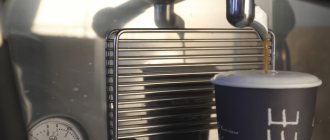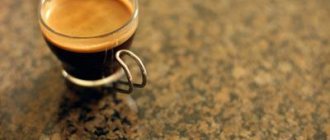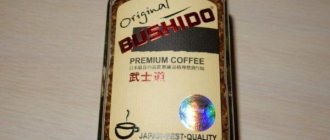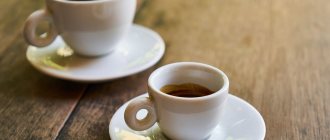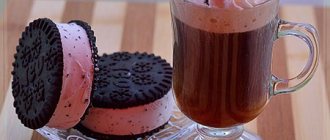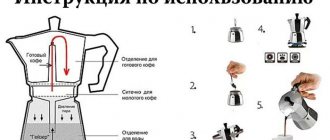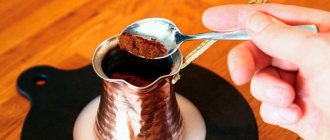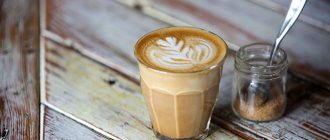Espresso is the most expensive, aromatic and tart type of coffee, which is loved by true gourmets and connoisseurs of strong drinks. It has a velvety rich taste and a long hot aftertaste. Despite the complex technology for creating this wonderful drink, it can be prepared at home. Moreover, now all the necessary tools are easy to find on the open market.
Espresso at home can be created using a Turkish coffee maker, coffee maker or automatic coffee machines. Turka provides complete control over the process of creating a drink, and the coffee maker is a mixed device with an automatic water supply mode and independent placement of coffee tablets into the cone. The quality of espresso made in a carob coffee maker depends on the coffee you choose and the ability to properly compact it in the filter reservoir.
Automatic coffee machines are the result of the latest technologies, which have reduced the process of making coffee to a minimum of time. The process from feeding the coffee base into the brewing tank to obtaining an aromatic drink takes no more than 40 seconds. These coffee machines are equipped with automatic programs that automatically add the necessary ingredients and regulate the strength of the espresso.
Not long ago, combination harvesters appeared on the market, combining the functions of a coffee grinder and coffee maker. This type of machine is convenient to use at home, as you will always have freshly ground coffee on hand, preserving its taste and aroma. However, as with a carob coffee maker, the quality of the drink will depend on your ability to properly compact the espresso coffee base in the machine's reservoir.
Expresso coffee
Ingredients:
- fine ground coffee
- sugar
- water
Cooking method:
- Pour finely ground coffee and sugar into it, stir the contents and place the cezve over low heat without adding water first.
- Heat the aromatic mixture well, but make sure there is no smoke.
- Next, pour warm water into the container with coffee and bring the future espresso to a boil.
- After this, remove from heat and stir the contents.
- Place the Turk back on low heat and let the liquid boil.
- Now you can turn off the heat, cover the dish with a lid or saucer and allow the thick mixture to settle to the bottom.
- Espresso is served in small cups with thick walls, preheated with boiling water.
Enjoy your coffee!
Selection of coffee beans
The first rule of creating the right espresso is choosing the right coffee base. You can purchase a ready-made mixture in a package marked “espresso” or select beans for subsequent grinding. The latter should have a strong degree of roasting, but not be over-roasted, otherwise the coffee will taste bitter. When creating a mixture yourself, you need to take Arabica and Robusta beans in a 2:1 ratio - then the taste will be tart and rich!
The finished espresso mixture should be very finely ground, similar to river sand.
It is preferable to choose Italian coffee varieties, since they more often than others sell pure raw materials without flavored additives.
Espresso coffee at home
Ingredients:
- Ground or whole coffee beans
- Filtered water
- Granulated sugar
- Salt
Cooking method:
- We grind coffee beans in a coffee grinder, you can use an electric coffee grinder, or, even better, you can use a manual coffee grinder.
- If you prefer to use pre-ground coffee, that's fine too. We take a small amount of teaspoons of ground coffee, it all depends on what strength you need, and put it in the Turk.
- Add sugar to taste.
- We also add a quarter teaspoon of coarse salt to the coffee.
- Mix the dry mixture of coffee, sugar and salt thoroughly and place on low heat.
- After the dry mixture has warmed up thoroughly, pour in heated water and place on low heat.
- After the coffee and salt begins to boil (foam rises), quickly remove from the heat, mix the liquid with the grounds with a teaspoon and return the pot to the heat.
- Secondary rise of the foam and remove the espresso coffee from the heat completely.
- Cover the coffee with a saucer and give the grounds some time to settle.
- Pour the finished drink into cups and you can taste it.
- I think I answered the question of how to make espresso coffee at home, and much tastier and better quality than in any bar.
Enjoy your coffee!
Espresso in French press
To avoid damaging the glass, first rinse the glass with hot water. Place four tablespoons of ground coffee in the bottom of the container. As soon as the water in the kettle begins to boil, turn it off and pour in coffee for two servings (500 ml). Do this slowly and carefully.
Then begin vigorously stirring the resulting mixture, and then slightly lower the press filter down. Let the drink steep for about five minutes - the longer, the stronger the coffee. Now slowly lower the filter all the way and pour the espresso into the cups. Be sure to use a strainer.
Homemade espresso recipe
Ingredients:
- Coffee
- Filtered water
- Granulated sugar
Cooking method:
- Pour coffee powder into the coffee maker holder and compact it with tamper.
- If done correctly, the water will flow through the powder very slowly.
- Standard 30 ml should be obtained in 20-30 seconds.
- The foam will be reddish and dense, with veins.
- If it turns out light, it means there was either not enough powder, or it was ground too coarsely.
- Try making the grind finer.
- If, on the contrary, the foam is dark, then either the grind is too small or there is a lot of coffee poured in.
- And a small detail: if you preheat the coffee maker by first filling the cup with just water, and only then start making coffee, the drink will turn out tastier.
- Water quality is also of great importance.
- Bad water can ruin any drink.
- Try different ones and compare.
- I have a good water filter, I'm happy with it.
- You can try different types of bottled.
Enjoy your coffee!
And a little more about espresso
Selling coffee is a profitable business
Coffee is considered to be the most marginal commodity. The markup on it is several hundred percent. Like the price of any other product, the price of coffee is made up of the cost of the products used in preparation. The calculation takes into account cooking time, employee costs, water and electricity used. Establishments also take into account the cost of their rent. In Moscow, the price of espresso starts from 150 rubles. per cup.
Coffee is considered one of the most common commodities in the market. It ranks second after oil. Coffee is one of the most amazing drinks with a long history. Coffee lovers are much less likely to visit the dentist because coffee contains elements that prevent bacteria from settling on tooth enamel.
Classic espresso
Ingredients:
- 15 gr. ground Arabica, it is better to take the beans without roasting.
- 60 milliliters of water.
- granulated sugar.
Cooking method:
- Yes, the list of necessities is very modest, but nothing more is required to make espresso coffee at home.
- Now let’s start describing the stages of brewing coffee step by step, the instructions are as follows
- First of all, we prepare the beans, espresso coffee requires well-roasted, but not burnt, beans, so be careful when roasting.
- We've fried it, now we start grinding.
- The grinding should not be too fine, reminiscent of flour, light granules should still be “visible”.
- Ground espresso coffee with your own hands will make the drink just perfect.
- We place the empty pot on the stove and heat it up, pour our “ideal Arabica” into the heated cezve.
- Return the cezve to the fire and warm up the ground grains just a little.
- Add water to the pot; it is better to take filtered cold water.
- Stir and put on the stove to cook.
- We brew the espresso, wait for the foam to rise, it has risen, stir the “brew”.
- This procession with foam must be repeated three times.
- At the end of cooking, you should get a lush and fairly dense foam, remove the Turk from the stove.
- Remember, coffee should not be boiled
- As soon as it starts to bubble, remove the Turk from the stove.
- Using a spoon, remove the foam from the surface of the espresso and place it in your drinking cup.
- Pour the coffee on top and add the required amount of granulated sugar and stir.
Enjoy your coffee!
Types of espresso and their preparation
Perhaps not everyone will like only the classic version of this invigorating and bright drink. At home, you can prepare several versions of it, depending on the amount of ingredients:
- Actually a classic version. For 30 ml of water, take one teaspoon of finely ground coffee. Prepared according to the previously presented recipe in Turk.
- Doppio. From Italian this word is translated as “double”, that is, all the ingredients of the classic version are doubled, everything is prepared without changing the technology.
- Ristretto. A more “strict” option, when half as much water is taken to make the drink even more rich. Suitable for true connoisseurs of espresso coffee.
- Macchiato. To prepare this variety at home, simply add a little milk on top of the finished drink, brought to a foamy state.
- Lungo. Add the finished coffee with hot water to obtain a volume of 50 ml.
- Konpanna. Pour a standard amount of espresso into a cup. You can optionally add whipped cream, grated chocolate, and lemon zest on top.
- Romano. This citrus option is designed to refresh the coffee and diversify it. A small slice of lemon or orange is simply served with espresso brewed according to the classic recipe.
- Coretto. As an addition, for example, whiskey or liqueur can be used. Moreover, there are special names for such drinks depending on the type of alcohol chosen. Espresso with whiskey is Irish coffee, with vodka is Russian coffee, with schnapps is German coffee, with gin is English coffee. If we take the Italian version, then it is traditionally amaretto.
- Glasse. To prepare it, espresso is brought to a temperature of 10°, and then ice cream, cinnamon, chocolate or caramel are added as desired in proportions of 1:3.
- Cappuccino. A special feature of this type is the abundant milk foam. In Italy, it is customary to drink cappuccino for breakfast. You can add grated chocolate on top.
- Americano. In fact, this is a standard shot of espresso, diluted to the full volume of a coffee kettle. They are usually served in standard cups (120 ml).
- Latte. Here, rather, coffee acts as an addition; the basis is heated milk, into which espresso is poured in a small stream. On top is milk foam.
- Mocha. This is the same latte, only in changed proportions. Espresso and toppings are taken in a ratio of 1:3.
Turkish espresso coffee recipe
You can properly prepare this strong and invigorating drink not only in a coffee machine, but also with the help of an ordinary Turkish coffee pot. This process will take no more than 10 minutes, and the result will please the most scrupulous coffee lover.
Ingredients:
- finely ground coffee – 7 g;
- water – 30 ml;
- Turk.
Cooking method:
- Ground coffee beans are placed in a Turk and filled with clean drinking water.
- Before starting cooking, it is advisable to warm the Turk a little.
- The espresso is brewed over low heat until the coffee foam rises.
- Do not allow it to boil, otherwise the drink will lose its rich taste.
- After foam appears, remove the coffee from the heat, stir the contents of the Turk with a teaspoon and put it back on the heat.
- Wait until the foam rises again - the espresso is now ready.
- Leave the drink for a couple of minutes for the grounds to infuse.
- Pour the coffee into special cups called “demitas”.
- You can enjoy amazing rich coffee taste
Enjoy your coffee!
What is espresso
It contains only 2 ingredients: water and ground coffee beans. You can see the drink in the photo. Read the description before use.
Creamy foam
The golden foam that forms on the surface is called “creama”. The Italians claim that it is the juice of coffee beans. Water entering under pressure dissolves carbon dioxide, resulting in the formation of a dense cap. The foam should be uniform. Whitish spots indicate excess caffeine.
Liquid part
The liquid part is conventionally divided into 2 halves. Immediately below the foam is a caramel-brown “body”. The “heart” is at the bottom of the glass. This part is a darker brown shade.
Espresso recipe from a real barista
Ingredients:
- finely ground coffee
- water
Cooking method:
- The first step is to place the ground coffee into the filter tank.
- The espresso base should be moderately dense so that water can seep through the coffee tablet evenly.
- Therefore, the mixture should be compacted with vigorous pressing movements, as if compressing it.
- Before pressing the pour button, you can do an interesting trick: lightly hit the ear (protruding part) of the holder to shake the coffee off its walls.
- It is also advisable to clear the coffee paths of any remaining grounds from the previous shot of espresso.
- Now we insert the holder into the coffee machine reservoir and immediately turn on the water dispensing button.
- This is necessary so that the coffee tablet does not have time to undergo a temperature change, otherwise the drink will become bitter.
- The appearance of golden nutty foam indicates that you have successfully prepared espresso.
- By the way, it is by the quality of the foam that you can determine whether the technology for its creation was followed correctly.
- The recipe from the barista assumes the presence of smooth and dense foam, the thickness of which should be at least 2 mm.
- To ensure that the foam turns out exactly like this, use a little trick: before preparing the drink, place the cups on the surface of the coffee machine so that their inner walls warm up.
- In this case, there will be no temperature difference after the water is supplied.
Enjoy your coffee!
How to serve espresso
Even well-prepared espresso can lose its taste if special rules for serving this coffee drink are not used:
- Espresso is poured into special cups with thick walls - demitas. They are made of porcelain and have an interesting shape, gradually expanding towards the top. The cup volume is 60 ml, which corresponds to a standard portion of classic espresso.
- Coffee must be served in a warm cup. You can first hold hot water in it or use the heating function, which is provided in some models of coffee machines.
- When pouring espresso, make sure that the drink takes up no more than 2/3 of the volume of the cup, otherwise it will quickly lose its temperature and its taste.
Coffee Espresso
Ingredients:
- Coffee
- Water
Cooking method:
- First of all, fill the coffee machine reservoir with water or connect it to the water supply (if your machine has such a function).
- Make sure the water has been filtered.
- Turn on the coffee machine and give it enough time to warm up.
- Depending on the size of your device, this may take up to 45 minutes, check this information with your manufacturer or check the instructions.
- Grind a few grains to a powder, but do not turn them into flour, the granules should be distinguishable.
- Add 18-21 g. ground coffee into the portafilter and press down
- Place the filter back into the machine and start the process.
- Before serving, stir the foam or pour the coffee into another cup.
Enjoy your coffee!
Differences between Americano and espresso coffee
Most people mistakenly believe that Americano and espresso are two similar drinks. Their composition is really similar to each other, but they are prepared completely differently.
Espresso has a richer coffee flavor than Americano
Main differences:
- To prepare an Americano, espresso is diluted with water to 180 ml. It turns out that 40 ml of espresso requires three times more water.
- Americano contains less caffeine. It has a weaker coffee taste.
- Americano is rich in fruity and woody flavors.
- To decorate the weak taste of Americano, milk and sugar are added. It is served mainly in large cups.
- Espresso has a stronger and richer taste.
Espresso at home
Ingredients:
- Strongly brewed coffee
- 2% or skim milk
- Cocoa powder (if desired)
Cooking method:
- First you need to brew strong coffee.
- To do this we will use AeroPress.
- Next, pour the milk into the jar, about halfway, close the lid tightly and shake it as hard as possible.
- It is advisable to carry out this procedure for at least 30-60 seconds.
- Then open the lid and place the jar in the microwave for 30 seconds (adjust the temperature yourself).
- The microwave stabilizes the milk.
- Pour warm milk into the coffee, holding back the foam with a spoon.
- Add foam or whipped cream on top.
- Sprinkle with cocoa powder or nutmeg if desired.
- If you like flavored drinks, then fruit syrup should be added along with warm milk
Enjoy your coffee!
How many grams of coffee do you need for a cup of espresso?
For a traditional 35-40 ml espresso shot, 7 grams of ground coffee will be enough. If you want to brew double espresso, then the portion of coffee needs to be increased to 14-15 g.
Experts advise using 10 grams. coffee for an espresso shot if you are making coffee from Arabica beans. It is not so strong, so the portion of ground grain can be increased if you want to get a strong drink.
In some countries, the serving of espresso is larger than Italian rules dictate. So, in the USA, espresso can reach up to 100 ml, and in northern Europe a serving is 60-80 ml, but the same 7-10 grams of ground coffee are added to a cup of espresso.
Delicious espresso with milk
Ingredients:
- one teaspoon of grain, ground or instant strong coffee,
- half a glass of hot boiled water and one glass of milk
Cooking method:
- It is best to prepare a latte in a special tall Irish glass and serve with a comfortable high spoon.
- Brew coffee in a way that suits you.
- In a coffee maker, coffee machine, or simply pour boiling water in a mug if you are using instant coffee.
- The coffee must be strong enough.
- The most delicious latte will be made from a coffee mixture that will contain at least 10-20% robusta.
- Pour the milk into a separate container, it is best to use a French press, and heat it up a little, the main thing is not to bring the milk to a boil.
- It is enough to heat it to 50-60 degrees.
- This can be done either on an electric stove or in a microwave oven.
- It will be enough to put milk in the microwave for 40 seconds, setting the power to 600 W.
- Now you need to beat the milk using a blender or mixer.
- Beat thoroughly, at least 3-5 minutes, until an airy foam forms; as a result, it should be much fluffier than cappuccino foam.
- If you don’t have a mixer or blender at hand, you can use the same French press.
- Pour milk into it, close the lid and move the piston up and down over the surface of the milk.
- The foam should also be very thick and rich.
- Then you need to pour the milk into a pre-prepared tall transparent Irish glass.
- Carefully spread the foam on top if there is any left in the mixer or blender.
- After this, carefully pour the brewed coffee into the milk in a thin stream.
- The stream must be very thin, only then can you taste a real latte.
- The layers of coffee, milk and foam should not mix with each other.
- If you froth the milk correctly and carefully pour in the coffee, you will have a flaky, three-layer cocktail.
- The coffee should be between the milk and the milk foam.
- Clear identification of all three layers is the main sign that you have a real latte coffee.
- Finally, if you wish, you can sprinkle the top of the latte with grated chocolate or cinnamon.
Enjoy your coffee!
Secrets of Italian espresso
A barista is a professional in making coffee. Nowadays, various meetings of coffee lovers are held around the world, where everyone shares various secrets and new coffee recipes. Italians believe that you can master art only if you work for many years.
A good barista knows over a hundred different coffee recipes in his head. How to do it quickly, tasty and efficiently. He considers Espresso his best friend. He, like all Italians, can determine by the color of the drink and the quality of the foam what varieties it is made from and determine what the taste will be.
Espresso is served within 1-1.5 minutes after preparation in small coffee cups. It is customary to serve a glass of clean water at room temperature with coffee.
Before drinking coffee, you need to take 1 sip of water. This is done in order to “cleanse” the receptors and experience the taste of the coffee drink as much as possible. It is recommended to drink espresso as quickly as possible, because over time the taste and aroma become distorted.
It is recommended to snack on espresso: dark chocolate, fruit, hard cheese, meat/cheese/vegetable/fish plate.
In order not to harm your health, doctors recommend 1-2 cups of coffee per day. Sometimes the dose can be increased. But it is strongly not recommended to abuse the drink, since coffee puts a lot of pressure on the heart and can cause problems with the human cardiovascular system.
How does an espresso coffee maker work?
There is nothing better than freshly prepared espresso coffee at home in a coffee maker.
Most often, coffee is brewed like this: purified water is combined with ground coffee beans, then brought to a boil and boiled for some time. Then pour the coffee into a mug and enjoy!
If you are the happy owner of an espresso coffee maker, then the principle of its operation is significantly different. In such coffee makers, the drink is prepared without any water at all. Under high pressure, steam passes through the coffee powder, where all the flavors of the coffee are revealed. The steam turns into condensate and you find your favorite drink!
This coffee machine can prepare a huge variety of coffee options that your guests will love!
If we start comparing two types of coffee makers, the steam coffee machine undoubtedly wins! The pronounced taste and aroma will not leave anyone indifferent!
Expresso with milk (latte)
Ingredients:
- 10 g coffee (ground)
- 80 ml filtered water
- 150 ml frothed milk
- 2 tsp Sahara
Cooking method:
- First, grind the beans in a coffee grinder.
- You can also use ready-made ground or instant coffee if there is no other option.
- But as you can imagine, whole beans make the most delicious latte.
- Well, pour the prepared powder into a Turk and, filling it with the planned amount of water, cook until it boils over minimal heat.
- Make sure the coffee doesn't run away.
- At the same time, bring the full-fat milk to a boil (but not a boil), which we immediately pour into a tall metal container (like a mug or glass) and beat the liquid with a mixer until a stable foam appears.
- If the milk is at the required temperature (60-70 degrees) and fat content (from 3.2), then you will do this in 1-2 minutes.
- If you're worried it won't foam (or it does), add a little cream.
- Moreover, they can be whipped together with milk, or you can do this in a separate bowl and lay them out as a top layer at the end of our culinary process.
- At the next stage, remove the finished coffee from the heat, pour white sugar inside to taste and mix the drink well.
- Next, take the glass of milk in your hand, carefully lift it a couple of times and sharply lower it to the table surface.
- Such blows will destroy large bubbles in the foam, making it more stable and uniform in consistency.
- All the ingredients are ready, all that remains is to design our drink.
- To do this, pour the strained coffee into a tall glass glass, preferably narrowed at the bottom.
- Now add warm milk in a thin stream, trying to keep the foam on top.
- If everything is done correctly, you will get three layers: creamy coffee, white milky and delicate foam.
- By the way, it can be decorated with cinnamon or finely grated chocolate.
- But in addition to the classic version, many baristas offer other latte recipes, which we will introduce you to in this collection.
Enjoy your coffee!
Rules for making espresso
Classic espresso differs from other types of coffee in the absence of impurities: milk, cream, alcoholic beverages, spices. By adding these ingredients in various proportions to espresso, you can get several dozen other coffee drinks.
Characteristics of espresso (table)
| Bean varieties | A mixture of several varieties of Arabica, possibly adding a small amount of Robusta |
| Roasting degree | From medium (Full City or Viennese) to dark (Italian or French). The darker the roast, the more bitterness the taste and the less sourness. |
| Grinding | Fine or medium espresso |
| Coffee machine pressure | In the espresso chamber - at least 9 bar, pump operating pressure - at least 15 bar |
| Group water temperature | For medium roast coffee – from +91 to +93 °C, for dark roasted coffee – from +88 to +91 °C |
| Ready coffee temperature | At the outlet of the holder spout - +88 ± 2 °C, in the cup - +67 ± 3 °C |
| Cooking duration, seconds | 25–30, depending on the coffee maker model |
| Portion output volume, ml | 25–30 (including foam) |
| Caffeine content (strength) | 50–68 mg (per serving) |
| Recommended intake (servings per day) | 1-3 |
| Maximum permissible norm (servings per day) | 7 |
| Calorie content | 9 kcal per 100 ml, 2.25 kcal per serving |
| Calories with sugar | 21.60 kcal - a serving of coffee with 5 g of sugar (1 sticker) |
Italian coffee connoisseurs believe that the quality of espresso is influenced by 4 factors, which for ease of remembering are called the 4 m rule:
- miscela (mixture) – a well-chosen mixture of grains;
- macinadosatore – grinding;
- maccina – coffee machine;
- mano (hand) – barista skills.
Selecting coffee for espresso
The main advantage of espresso is its full-bodied taste and rich aroma. Arabica has a wonderful aroma, which is why espresso mixtures contain the most of these beans. But if you brew espresso from beans of any one variety, the aroma will be much poorer, “one-sided”, than that of a mixture of different Arabica varieties.
For greater strength, a little robusta is added to such mixtures, which is almost 2 times richer in caffeine. Robusta has one more feature: it produces dense foam.
When buying coffee beans, you need to pay attention to whether there is a foil valve on the package. Only if it is present does the coffee retain its aroma throughout its shelf life.
In specialized stores you can make the mixture yourself, but there they sell loose coffee in paper bags. This coffee retains its aroma for no longer than 2 weeks from the date of purchase.
When purchasing ground coffee in packs, it is important to ensure that it is sealed. After opening the package, it is better not to leave the coffee in the pack, but to pour it into a glass container with a sealed lid. You should do the same with excess self-ground coffee. But after 2-3 weeks of storage, the smell of ground coffee weakens.
The best aroma comes from espresso made from beans ground immediately before preparing the drink. Even if several hours pass between grinding the beans and brewing the coffee, the coffee will have time to become damp and even stale a little.
Ground coffee with aromatic additives is not suitable for making espresso: it is impossible to predict how artificial flavors will behave in an espresso coffee maker.
Grinding coffee for espresso
It is important to know the rules:
- if the grind is too fine, the stream of coffee poured into the cup becomes almost black, and small particles can clog the coffee maker filter;
- When grinding coarsely, the espresso turns out liquid and tasteless.
There is a special fine espresso grind: finer than medium, but coarser than fine. However, you can also use medium grind coffee. Experienced baristas advise using slightly coarser ground coffee in wet weather: this powder absorbs moisture more slowly.
Correct grinding
Choosing a coffee maker
Each model of coffee maker or coffee machine has individual features that are important to study.
Signs of a good espresso coffee maker:
- stainless steel holder. No matter how high-quality the plastic holder is, when heated it adds unpleasant chemical odors to the aroma of espresso;
- the optimal pressure in the espresso chamber is 9 bar, the pump should provide a pressure of 15 bar, you should not buy coffee makers with lower values of these parameters;
- the water in the boiler should be heated to a temperature from +87 to +95 °C. At a lower temperature, the coffee turns out to be liquid and insufficiently extracted; at a higher temperature, there are hints of burning in the drink.
Tamping the coffee in the holder with a tamper is a mandatory step.
Preparing to brew espresso
To make espresso rich and aromatic, you need to take into account some subtleties:
- Even if you want to make the espresso stronger, you cannot pour too much coffee into the holder: in this case, it will be difficult to compact it with a tamper. If the ground coffee is not pressed evenly, water will flow through areas of less density. As a result, the drink will be liquid;
- It is important to choose the right tamper. Preference should be given to stainless steel tampers: aluminum and plastic ones are too fragile. The flat base tamper is suitable for both single and double holders. But Americans prefer to use tampers with a convex (spherical) base for double holders: it compacts the center of the tablet most intensively, and presses the edges against the walls of the portafilter. As a result, the surface area of the particles washed by water increases;
- ground coffee for a carob coffee maker is compressed, applying a force of 19–20 kg to the tamper;
- If you use too hard water, the coffee turns out bland and unflavoured; if you use distilled water, the taste deteriorates and the strength decreases. For espresso you need moderately soft, filtered or bottled water (mineralization – 75–250 mg/l, optimally – 150 mg/l) without chlorine ions;
- the finished coffee should be poured into a preheated cup, preferably a ceramic one;
- espresso cannot be poured from one container to another;
- the foam should be uniform in color. White spots are a sign of excess caffeine in a serving.
You can't make espresso without a coffee machine
Ice espresso with milk
Ingredients:
- 110 ml milk
- 60 ml espresso
- 10 ml chocolate syrup
- 5 ml vanilla syrup
- 5-6 ice cubes
Cooking method:
- Mix the finished espresso with vanilla and chocolate syrup.
- Crush the ice cubes (or use whole ones) and pour into a tall glass.
- Then pour the sweet aromatic coffee inside, then carefully, in the thinnest stream possible, introduce the boiled milk, whipped to foam.
Enjoy your coffee!
How much espresso can you drink per day?
A safe dose of caffeine for a relatively healthy person is considered to be 300 mg, that is, about 5-6 servings of espresso of 40-50 ml. We recommend postponing your main coffee consumption until 16:00. The greatest positive effect of espresso is achieved in the morning and after lunch. In the evening, it is better not to drink caffeine-containing drinks, so as not to provoke the nervous system into overload.
Expresso Macchiato
Ingredients:
- 2 teaspoons ground Arabica.
- 200 ml. hot water.
- Fat milk can be 5% fat - 250 ml.
- Sugar to your taste.
Cooking method:
- The list of ingredients that will start the process of making latte macchiato coffee is very modest and without any strange products.
- Now let’s go through the steps of preparation step by step, the instructions for home baristas are as follows
- First of all, you must brew a strong espresso, and it is on its basis that our aromatic drink is prepared.
- Pour all the crushed Arabica beans into a Turk and add hot water.
- Move the resulting “slurry” and place the Turk on the stove, turn on the gas and cook.
- Cook until the “brew” begins to boil.
- We repeat this procedure with “under-boiling” 5 times.
- All manipulations were carried out, the espresso was removed from the stove and set aside.
- You can add sugar.
- Our 5% fat milk should form a nice, fluffy foam in the drink.
- If you took milk with a fat content of 2.5%, then you would not achieve foam.
- Pour the milk into a saucepan and put it on the stove to warm up.
- Heat it up and remove it as soon as the boiling process begins.
- We take a kitchen whisk in our hands and begin to actively whisk the milk in the saucepan.
- Beat until foam forms.
- Foam has formed, pour it into a tall glass.
- Now there will be a scheme for mixing two ingredients, we act carefully and slowly, because this is the only way to get a delicious latte macchiato with beautiful layers that smoothly flow into each other.
- You need to pour the espresso in a thin stream into the tall glass where the milk foam is located.
- Raise the saucepan with coffee higher and then everything will work out.
- The espresso should penetrate straight into the middle of the glass, turning the foam a brownish tint.
Enjoy your coffee!
Espresso based drinks
To diversify the taste and for many other reasons, Italians began to dilute classic espresso with various additives - milk, cream, alcohol, fruit, which is why new drinks appeared:
- coffee with a cap of frothed milk - espresso Macchiato;
- a little grappa (liqueur) in a cup - Corretto is ready. In extreme cases, Irish whiskey is added instead of grappa;
- By adding boiling water (up to 90 ml) to a classic shot of espresso, you get an Americano. To independently regulate the strength of the drink, sometimes water is served separately;
- dilute with lemon juice (no more than 5 ml), sprinkle the foam with lemon zest for aromatic Romano;
- espresso with whipped cream - Con Panna;
- coffee with the addition of ice cream - ice cream.
Sometimes they just pour in 1-2 tsp. cognac, drink coffee with cognac.
Caramel expresso macchiato
Ingredients:
- Water (2 cups).
- Sugar (1.5 cups).
- Vanilla extract (3 ml).
Cooking method:
- Pasteurized milk (250 ml).
- Espresso (60-80 g).
- Liquid caramel (4 teaspoons).
- Vanilla syrup (2 teaspoons).
- Place water with sugar in an enamel saucepan and bring it to a boil, then simmer for five minutes over low heat.
- Vanilla syrup should be added in a small amount at the end of cooking.
- Stir the caramel as soon as you remove it from the heat.
- Pour the mixture into a glass jar or bottle when it has cooled.
- Now you can move on to preparing the macchiato itself.
- For this you will need
- Heat the milk, but do not bring it to a boil.
- Brew espresso.
- Add vanilla syrup to warm milk and beat the mixture with a mixer - foam should form.
- Pour it into glasses (they should be 2/3 full).
- Pour hot coffee into glasses with foam, but be careful: it should not mix with milk.
- Use caramel to decorate the macchiato and the drink is ready.
Enjoy your coffee!
Coffee Frappe
Brew a shot of espresso in its classic variation and let it cool. To prepare, you will need a glass that can be hermetically sealed, such as a shaker. We pour the prepared coffee there, add a couple of teaspoons of sugar and no more than 5 tablespoons of water.
Close the glass and shake it thoroughly - you should get plenty of foam. Now take a serving glass, a transparent one will look very advantageous. Place a few ice cubes there and pour the resulting coffee foam on top.
If you find the drink too strong, you can add cream or cold milk to taste. All that remains is to mix everything.
Expresso with milk
Ingredients:
- 100 ml milk;
- coffee beans;
- sugar and/or cocoa powder (to taste);
- a cup of espresso (volume about 70 ml).
Cooking method:
- Whisk the milk directly into the espresso cup;
- Place a cup under the coffee dispensing spout and dispense espresso coffee;
- Sprinkle with cocoa powder.
Enjoy your coffee!
Characteristics of espresso
The drink has a number of features.
Standard volume
For a classic espresso shot, the volume varies from 25 to 30 ml with foam. In Russia and Scandinavia they prefer to add more water, up to 60-80 mg.
Caffeine content and daily intake
One classic serving contains 50-68 mg of caffeine. It is recommended to drink no more than 1-3 shots per day. In some situations, it is allowed to increase the dosage to 7 cups. This amount of strong coffee cannot be drunk regularly.
Calorie content of the drink
Calorie content per 100 g is 9 kcal. The energy value of a serving depends on how many grams of coffee it contains. On average, the figure varies from 2.5 to 3 kcal.
Beneficial features
When consumed in moderation, the drink will benefit the body:
- The risk of developing cancer is reduced.
- If you drink a cup after a meal, the food will be digested faster.
- Coffee will help you cheer up. Drinking the drink before training can improve your performance.
- If a man prefers to drink espresso in the morning, his potency and libido will increase. You should not drink coffee in the evening, as the effect will be the opposite.
- Drinking the drink between meals will help reduce appetite and prevent overeating.
- Regular consumption improves mood and stimulates brain function.
Harm to health
Pregnant and lactating women should avoid strong coffee. Caffeine can cause uterine contractions and cause miscarriage or premature birth. The substance penetrates into breast milk and overloads the baby’s nervous system.
Drinking a cup of espresso on an empty stomach will lead to heartburn, discomfort, and abdominal pain in people with disorders of the digestive system.
It is dangerous to drink coffee if you have pathologies of the heart or blood vessels. The drink increases blood pressure and increases heart rate.
Espresso quality check
Coffee prepared using this technology has a bright, rich taste without bitterness. The quality and adherence to the cooking technology can be judged by the color and height of the foam.
- Classic espresso has a stable and dense foam of an even golden color with a thickness of 2 to 5 mm.
- You can check its consistency as follows: sugar poured on top lingers on the surface for some time and only then sinks to the bottom of the cup.
- When you tilt the cup, the cream should remain on the walls, and if you push it away with a spoon, it will quickly recover, covering the entire surface of the drink.
- A foam that is too light indicates that the coffee is not strong enough, and a foam that is too dark indicates a sharp, bitter taste.
After preparing espresso in the coffee machine, you should check the tablet: it should not crumble or be too wet.
By following our advice and following technology, you can independently prepare aromatic and invigorating coffee for yourself and your loved ones.
Cooking equipment - Turk, French press and others
The cheapest, but not the easiest way to prepare the base is to brew espresso in a Turk, as they did in the East.
To make espresso you need very little:
- 100 ml of pure spring or distilled water;
- 15 g ground coffee;
- sugar to taste - white refined sugar or brown cane sugar.
How to prepare espresso coffee in Turkish:
- Pour tea leaves and sugar into a pot and place over low heat. The point is to warm up the components.
- When a characteristic aroma appears, add water.
- Bring to a boil, then remove from heat and wait a bit for the foam to settle.
- Repeat the third step twice more.
- Pour into cups when the grounds have settled.
The secret to the strength of oriental coffee lies in the method of grinding the beans. They are actually turned into flour so that during cooking all the substances and oils are transferred into water. You cannot boil the drink: as soon as the foam rises, the Turk is removed from the heat. If desired, spices are added to the cezve before cooking.
A French press is a convenient device that will come in handy on the road or in nature. The principle of operation is that when brewing, the grounds are separated from the liquid by a piston with a filter and grain particles do not fall into the cup. In this case, you can change the concentration at your discretion. The degree of grinding for this device may be coarser, since the brew is infused longer.
A geyser coffee maker allows you to get a good, strong morning drink at the lowest possible cost. To do this, water is poured into the lower part, then a container with infusion is installed and the upper part is screwed on, where the finished coffee falls.
Place the coffee maker on the fire and wait until the water boils and moves into the upper container. This can be heard by the hissing sound. Dairy additives can be added after preparing the base.
In Serbian
The Serbian recipe for making espresso in a Turk differs in the order in which the components are added. Everything is simple and the ingredients are the same:
- 2 spoons of tea leaves;
- sugar to taste;
- water 100 – 120 ml.
How to cook:
- Pour water into the Turk and add sugar.
- Put on fire and boil.
- Pour off half the liquid and add ground tea leaves.
- Bring to a boil and remove from heat.
- Add half the water and leave.
After the grounds settle, pour into cups.
Video: Barista School - preparing delicious espresso

